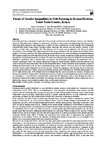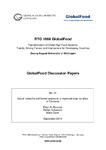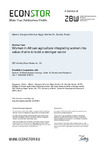Browsing School of Agricultural Sciences by Subject "Gender"
Now showing items 1-6 of 6
-
Farmers’ intrinsic values for adopting climate-smart practices in Kenya: empirical evidence from a means-end chain analysis
(Taylor & Francis, 2018-03-03)This study assesses intrinsic values and motivations farmers have for adopting various climate-smart agricultural practices in Kenya. The qualitative method of laddering was employed as an interview technique, and means-end ... -
Forms of Gender Inequalities in Fish Farming in Kwnza Division, Trans Nzoia County, Kenya.
(IISTE, 2013)Fish farming being a sub-sector in agriculture has a major contribution to the Kenyan economy and therefore should be fully promoted to enhance its productivity. To achieve this, women who form a large proportion of ... -
Gender and Educational Dimensions of Handicraft Industry in Mwala District, Kenya
(International Journal of Humanities and Social Science, 2014-09)In Kenya, communities have since time immemorial practised indigenous technologies such as woodcarving and basket weaving. The “kiondo” (African Basket) for example, is now an international handicraft while the woodcarvings ... -
Gender Differences in Climate Change Adaptation Strategies and Participation in Group-based Approaches: An Intra-household Analysis From Rural Kenya
(Elsevier, 2016-04)Existing studies on adaptation to climate change mainly focus on a comparison of male-headed and female-headed households. Aiming at a more nuanced gender analysis, this study examines how husbands and wives within the ... -
Social networks and farmer exposure to improved crop varieties in Tanzania
(2014-09)In Sub-Sahara Africa, adoption rates of improved crop varieties remain relatively low, which is partly due to farmers’ limited access to information. In smallholder settings, information often spreads through informal ... -
Women in African Agriculture: Integrating Women into Value Chains to Build a Stronger Sector
(2018-10)Women are under-acknowledged participants in Africa’s agriculture and food sector, supplying a large share of the labour, but facing significant obstacles, including unequal access to land, traditional division of labour, ...






